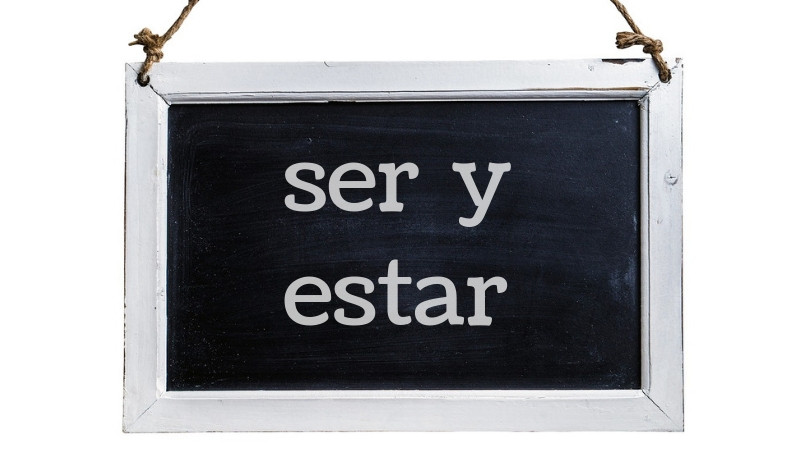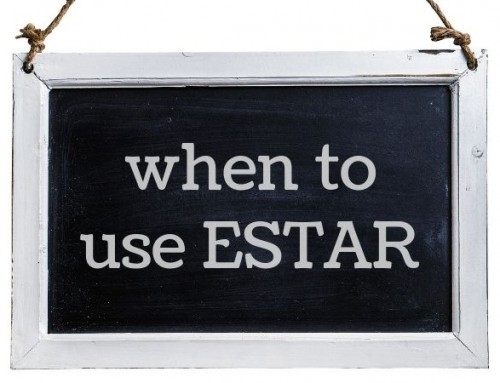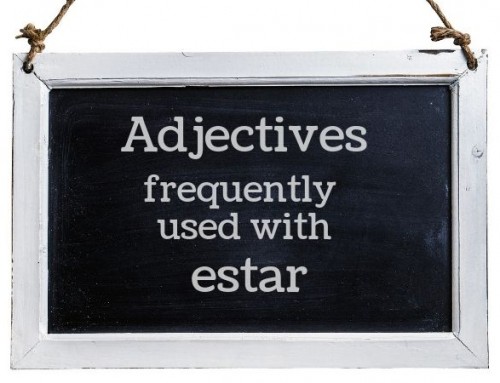The Conjugations & Contexts of SER and ESTAR (to be)
In this lesson, we’ll cover the difference between ser and estar. We’ll learn the conjugations of estar and the contexts in which to use them. This lesson also includes a ser and estar quiz to assist your comprehension of these two fundamental verbs of the Spanish language.
am, are and is are the conjugations of the verb to be. It’s the most important, most-commonly used verb in all of English. It’s challenging to learn because am, are and is don’t look or sound anything like each other. Nor do they look or sound like to be. In Spanish, the complexity of this verb is not due to its conjugations, but rather, the fact that it’s expressed by two different verbs; ser and estar.
The Difference Between ser and estar
ser is the most commonly-spoken verb in the Spanish language. ser implies being in a permanent sense to express things that are not likely to change. Our identity, origin and characteristics all fall under this category;
I am Joseph
You are tall
She is from Texas
On the other hand, estar expresses temporary situations such as how a person feels at a given moment or where something or someone is located. Unlike ser, estar expresses conditions that *are* likely to change.
I am tired
You are at work.
Contexts of estar
- To express the location and/or position of people, places and things.
- To express the temporary conditions (states, feelings, moods) of people, places and things.
Let’s focus first on estar. We’ll cover ser down below.
Conjugations of estar
The form of estar you use will depend on the subject of your sentence. In the same way that am follows I, are follows you and is follows he, estar has a corresponding conjugation for all of the subject pronouns. Here they are:
| yo estoy | I am | nosotros estamos | we are |
| tú estás | you are | ustedes están | you are (plural) |
|
él está ella está usted está |
he is
she is you are (formal) |
ellos están
ellas están
|
they are
they are
|
Keep in mind that the subject of a sentence is not necessarily the person who’s talking. But rather, it’s the person(s) or thing(s) they are talking about. For example:
| Yo estoy en el apartamento. | I am at the apartment. |
| Tú estás en el jardín. | You are in the garden. |
| El documento no está en la mesa. | The document is not on the table. |
| Tú estás nerviosa. | You are nervous. |
| ¿Cómo está Anna? | How is Anna? |
| La ventana está abierta. | The window is open. |
I may be the one speaking the above sentences. But only in the first example am *I* the subject. The other sentences are about someone or something else. Therefore, I must use the corresponding conjugation for those different subjects.
ESTAR conjugation quiz
Choose the correct form of estar for the following sentences.
Adjectives Frequently-Used with ESTAR
Since estar is generally used to express temporary locations and conditions, the adjectives that are commonly used with estar often describe a person’s feelings or momentary status. The following list includes several of these adjectives. Notice that adjectives like “tall,” “short,” “smart” and “funny” are not on this list. That’s because those adjectives are more descriptive of a person’s characteristics or permanent qualities. Therefore, these “more-permanent” adjectives are commonly expressed with ser.
Also, notice that most of the adjectives have a masculine form (ending in “o”) and a feminine form (ending in “a”). The form of the adjective you use will depend on the gender of whomever you’re describing. Only a few of the adjectives like bien, disponible and triste are “gender neutral.”
| aburrido, a | bored |
| avergonzado, a | embarrassed |
| bien | well / ok / fine |
| cansado, a | tired |
| cierto, a | certain |
| confundido, a | confused |
| contento, a | happy / content |
| disponible | available |
| emocionado, a | excited |
| enfermo, a | sick / ill |
| enojado, a | upset / angry |
| estresado, a | stressed (out) |
| frustrado, a | frustrated |
| furioso, a | furious |
| listo, a | ready |
| nervioso, a | nervous |
| ocupado, a | busy |
| preocupado, a | worried |
| preparado, a | prepared |
| relajado, a | relaxed |
| satisfecho, a | satisfied |
| seguro, a | sure |
| triste | sad |
Think about it…any person can experience any one of the above conditions in a given day. We all get tired, busy and sick sometimes, regardless of what kind of person we are. That’s why these adjectives are usually expressed with estar, the more temporary way to express to be in Spanish.
Opposite Adjectives Frequently-Used with ESTAR
Again, here’s another round of common adjectives that are usually expressed with estar. Most of these words describe things more often than they describe people. Nonetheless, the gender of the adjective should be the same as the gender of the thing it describes. An open book (libro m.), for example, is abierto. An open door (puerta f.), on the other hand, is abierta.
| abierto, a cerrado, a |
open closed |
| limpio, a sucio, a |
clean dirty |
| muerto, a vivo, a |
dead alive |
| mojado, a seco, a |
wet dry |
| sentado, a de pie |
seated standing . |
| ordenado, a desordenado, a |
neat messy |
| frío, a caliente |
cold hot |
| prendido, a apagado, a |
on off |
Adjective Agreement
Another layer of complexity to Spanish adjectives is that they must be “in agreement” with the number of people or things they are describing, in addition to their gender. As a result, there are 4 variations for most adjectives. For example, here are the 4 forms of the adjective wet;
| mojado
singular |
mojados
plural |
| mojada
singular |
mojadas
plural |
This is just one example of the complex rules of Spanish grammar which we discussed in another post (link). In contrast, there are no variations of English adjectives. They’re always the same, regardless of who or how many people or things they’re describing.
The dog is wet.
Charlie is wet.
Charlie and the dog are wet.
The window is wet.
Let’s make sure you understand this concept by taking another quiz. Simply choose the correct adjective from the multiple choice options.
Adjective Agreement Quiz
ser…o no ser (to be…or not to be)
ser is the most important and commonly used verb in the Spanish language. Although the verbs ser and estar both translate to English as to be, serstands in contrast to estar as it implies that a situation is more permanent or unlikely to change. Here are the conjugations of ser;
| yo soy | I am | nosotros somos | we are |
| tú eres | you are | ustedes son | you are (plural) |
|
él es ella es usted es |
he is
she is you are (formal) |
ellos son
ellas son
|
they are
they are
|
Here are some of the more common contexts in which ser is used.
Expressing Identity
| (Yo) soy Veronica. ¿Quién es ese hombre? Esa no es un lapiz. Es una pluma. |
I’m Veronica. Who is that guy? That is not a pencil. It’s a pen. |
Stating Relationships
| Miguel y Raul son mis hermanos. ¿Quién es tu novia? (Nosotros) somos buenos amigos. (Yo) soy el hijo del Sr. Williams. |
Miguel and Raul are my brothers. Who is your girlfriend? We’re good friends. I’m Mr. Williams’ son. |
Expressing Characteristics & Descriptions
This includes personalities, features and qualities that are unlikely to change.
| (Yo) soy responsable y diligente. (Tú) eres muy amable y generoso. ¿Cómo es tu padre? Los tacos de Taco Shack son enormes. |
I’m responsible and diligent. You’re very kind and generous. What is your father like? Taco Shack’s tacos are enormous. |
Indicating Nationalities, Ethnicities & Origins
| ¿De dónde eres/es usted? Soy Mexicano pero no soy de México. Mi coche es Japonés. Las manzanas son de Washington. |
Where are you from? I’m Mexican but I’m not from Mexico. My car is Japanese. The apples are from Washington. |
Stating Material, Natural Color & Calculations
| Las camisas son de seda y algodón. El cielo es azul. La hierba es verde. Dos y dos son cuatro. |
The shirts are made of silk and cotton The sky is blue. The grass is green. 2+2=4 |
Stating Occupations
No job lasts forever. In other words, occupations are not permanent. Nonetheless, ser is used to express a person’s occupation.
| Soy maestro. Miguel es ingeniero. Los Sres. Jones son abogados. |
I’m a teacher. Miguel’s an engineer. Mr. & Mrs. Jones are lawyers. |
Expressing Possession
| El libro rojo es mío. ¿De quién es ese dinero? Estas son las ideas de Roberto. |
The red book is mine. Whose money is that? These are Robert’s ideas. |
Stating Time, Dates & Days of the Week
| ¿Qué hora es? Son las siete y mieda de la noche. ¿Qué día es? Es el lunes. ¿Cuál es la fecha hoy? Es el diecinueve de agosto. |
What time is it? It’s 7:30pm. What day is it? It’s Monday. What is the date today? It’s the 19th of August. |
“It is” + (adjective) + (verb)
| Es bueno aprender nuevas cosas. ¿Por qué es difícil pronunciar la palabra? ¿Es necesario decir “yo”? Es imposible terminar el trabajo. |
It’s good to learn new things. Why is it difficult to pronounce the word? Is it necessary to say “yo”? It’s impossible to finish the work. |
SER conjugation quiz
Choose the correct form of ser for the following sentences.
Adjectives Frequently-Used with SER
The adjectives which commonly accompany the verb ser will describe an object’s inherent qualities rather than it’s temporary condition. Estar, for example, is used to say that a door is open, closed, clean or dirty. However, we’ll use ser to say that the door is big, heavy, wooden, etc.
| bueno, a malo, a |
good bad |
| pesado, a lijero, a |
heavy light (weight) |
| nuevo, a viejo, a |
new old |
| largo, a corto, a |
long short |
| posible imposible |
possible impossible |
| interesante aburrido, a |
interesting boring |
| complicado, a sencillo, a |
complicated simple |
| bonito, a feo, a |
nice / pretty ugly |
| fácil difícil |
easy difficult |
| duro, a suave |
hard soft |
| caro, a barato, a |
expensive inexpensive |
| grande pequeño, a |
big small |
More Adjectives Frequently-Used with SER
The adjectives on the above list are often used to describe things. The adjectives on the following list are typically used to describe people. They describe who a person is…what they’re like…rather than their moods or feelings.
| alto, a bajo, a |
tall short |
| jóven viejo, a |
young old |
| gordo, a flaco, a |
fat thin |
| rico, a pobre |
rich poor |
| trabajador, a perezoso, a |
hard-working lazy |
| simpático, a antipático, a |
nice / friendly rude |
| responsable irresponsable |
responsible irresponsible |
| amable maleducado, a |
kind / friendly rude |
| inteligente tonto, a |
smart dumb |
| paciente impaciente |
patient impatient |
| generoso, a tacaño, a |
generous stingy |
| fuerte débil |
strong weak |
Adjective Agreement Quiz
ser and estar quiz
Here we are at the end of the lesson. All we have left is the following ser and estar quiz. The quizzes above used only estar or only ser. The following quiz includes both verbs. Your challenge for most of the sentences is to determine which verb and which conjugation is appropriate for the sentence.





Leave A Comment